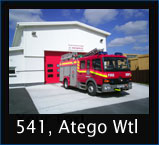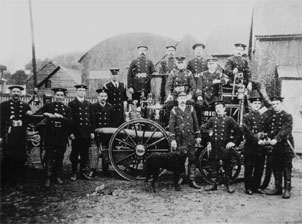Station History - Part 3IF you¹ve ever made a jigsaw puzzle you will know how confusing it can be if you put a piece in the wrong place. Well the history of Wadebridge Fire Brigade has been somewhat similar, but since last month¹s questions Mr Hoskin, May Garland, Geoff Dyke and one or two other people have provided very useful corrections, together with actual proof, enabling me to get a much clearer overall picture to complete the puzzle.
The first steam engine actually arrived in Wadebridge on November 17th 1909 having been presented to the Brigade by Mrs Emily Glencross. The following day it was steamed up for the first time and on the 19th a drill was staged on the Platt in front of the admiring townsfolk. Mrs Glencross was born in 1842, the daughter of the Revd. J Kingdon of North Petherwin, following the death of her first husband she married the Revd. James Glencross of Helland, she moved to Stonehaven in Trevanion Road in 1907 and took great interest in local affairs being mainly responsible for the discussions leading to her donating the first steam fire engine in the town.
The steamer was named Emily in her honour; she died in 1934, aged 92, and is buried at St Mabyn. It would appear from the records that until 1909 the pressure of water from hydrants in the locality supplied the hoses. In 1903 during a drill at Gonvena House ten leather and five canvas hoses were able to completely cover the house, but at Whiterock the pressure was only sufficient for one hose to reach the Chapel gates and no further, even the Chapel itself was beyond range of the water. At Egloshayle on fairly level ground hoses carried water over 735 feet, but up through Trenant Vale the last few houses could not be reached - too far down and you¹d get flooded, too far up you¹d pray for water if your house caught fire! Any photos of a steamer in Wadebridge prior to 1909 are almost certainly of the Bodmin Brigade who visited the town for displays and parades.
In 1905 the Brigade was called to a hayrick fire at Polshea, St. Tudy,
arriving there in under an hour and spending almost ten hours in extinguishing
it. Fund raising for the Brigade was held regularly and items purchased
included plates to be fixed on fireman¹s doors (do any still
The Brigade had received first aid training from Dr Eden until replaced by Dr Richards in 1908 and he in turn was followed in later years by Dr. Pellow (Photo in the Camel Practice Surgery). Harry Woolcock became the Brigade Bugler in place of E Hill in September 1907 and for a number of years a deputy had been appointed in case of need. August 1908 sees a rather mysterious entry of fire in Dr. Rendles garden at Gonvena but no further details, followed in September by a blaze at Henwood¹s Cycle shop in Molesworth Street which appeared to be very dangerous in view of the inflammable nature of liquids and materials stored there, the Brigade were praised for attending within four minutes and saving the premises from destruction.
With the arrival of the steamer in 1909 cleaning duty rosters were
drawn up and engineers appointed for maintenance, there were also details
of tests, leaks, holes, poor connections etc. on all hosepipes and Mr
Derry¹s tender for providing horses to tow the steamer was approved
at ten shillings per horse, per day. In July 1910 the firemen had an
outing to Fowey and took Emily Glencross with them, it is not clear
from the records whether this was Mrs Glencross, herself, or the steamer!
From the records it would appear that the first real action for the
steamer was on January 3rd
In October a more serious fire at Goodfellows shop saw the fire brigade in action within three minutes saving what looked like a very serious conflagration. There appears to have been very little activity for the Brigade from 1911 to the end of the first World War in 1918, the records only showing three farm fires and one false alarm. Emily the steamer remained in service until finally replaced by a very smart Leyland motor fire engine with its open Braidwood type body in 1936. With the approach of war the Auxiliary Fire Service was formed, manpower and equipment were considerably increased. Emily was stored in reserve at Wadebridge but most unfortunately with the Scrap Metal drive in the early war years our steamer was carried off for its metal content to be used in the war effort. Once again many thanks to those who have supplied this information. We hope to conclude the story next month with details of events leading up to, during and after the second World War. |
Wadebridge Fire Brigade shortly before the first World War, looking across rail sidings towards Gonvena House. |






